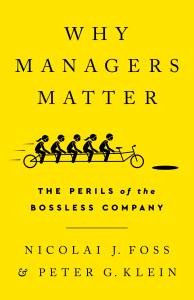On this Boss’s Day, how to be a better manager

Happy Boss’s Day, when we celebrate the managers and mentors who have helped us grow and flourish in our careers (and when we try and ignore the ones who never gave us feedback, denied our PTO requests, and made us work through the weekend for no reason).
But as we celebrate bosses, we also need to ask the uncomfortable question: Are they really necessary to begin with? In today’s world of supposedly flat companies, they can seem as outdated as a fax machine.
But they’re not, say two experts in the field of management.
The first is Eric J. McNulty, who’s written more than 200 bylined articles on leadership, decision making, and negotiation. His latest book, You’re It: Crisis, Change, and How to Lead When it Matters Most, takes you to the front lines of some of the toughest decisions facing our nation’s leaders — from how to mobilize during a hurricane or in the aftermath of a bombing to halting a raging pandemic.
The second is Peter G. Klein, the W. W. Caruth Chair and Professor of Entrepreneurship at Baylor University’s Hankamer School of Business. He’s co-author of Why Managers Matter: The Perils of the Bossless Company, a manifesto on managers and hierarchy that bucks the trend of the lean, flat, leaderless organization.
Klein and McNulty agree — even as more and more of us work from home and blur the lines between manager and direct report, a good boss is essential. So, how can you navigate the ever-shifting philosophies around corporate hierarchies and up your manager game?
[This interview has been edited for clarity and length].
Moderator: Eric, you open your book with the Boston Marathon bombing in 2013 and the pretty spectacular response that followed. Can you tell us more about that day and why it’s such a powerful example of what you call “swarm leadership?”
Eric McNulty: Yeah, it was 105 hours from the bombing until the final suspect was captured, and what we learned was that that response was no accident. It actually had started 10 years earlier, when Boston was going to host the Democratic National Convention, and folks realized they really weren’t ready to take out an event of that magnitude. That’s when they began building relationships, not just personally but also institutionally.
For January 1st, in April for the marathon, and for July 4th, there were joint training exercises and scenarios being run in the background. On one level, they were making sure the event was safe and secure. But behind the scenes, they’re also making sure everybody is trained to work together across agencies and jurisdictional boundaries and getting used to collaborating.
So when the bombs went off in the 2013, the response looked like it was spontaneous, but a lot of work had gone in to making sure people knew how to work together.
Moderator: Peter, this reminds me of what you describe in your book with organizations like Valve, the video game company. They’re seemingly “flat,” meaning no one is anyone else’s boss, but you argue that they actually do have a company structure. Am I getting that right?
Peter Klein: Absolutely. Some former Valve employees say that the company was a lot like high school. You had the cool kids who had a lot of de facto power, even if they didn’t have formal job titles. And then you had the — I don’t know — the nerds, the unpopular kids, whatever it might be, who ended up being bossed around by them. So what you found at Valve is that the widely advertised employee autonomy was kind of a sham. The employees really weren’t empowered.
Moderator: And that’s not the only problem you identify with flat organizations.
PK: No. One great example is Zappos, which embraced the concept of holacracy. Holacracy is a way of organizing workers in which people come together in short-term, task-focused teams. They call them “circles,” and different groups of workers spontaneously form a circle to work on a specific problem. When that problem is solved, the circle dissolves. It’s meant to be a very fluid, adaptive way of clustering people to work on particular problems.
But one thing about having more fixed sets of roles and responsibilities is that you know who everybody is. You know what everybody’s job is and where to go to get a certain thing done. With these fluid, ad hoc organic structures, who is related to whom? And who is coordinating with whom? It’s continually changing, so a lot of your time is spent figuring out who you need to talk to.
Moderator: Even ignoring those logistical hurdles — what you call coordination costs — that kind of structure really relies on people’s ability to cooperate and collaborate. But Eric, that’s not necessarily something we’re automatically good at, yes?
EM: Correct. We’ve been pushing the compete button since we were in kindergarten — your first day waving your hand to get a teacher’s attention because you’ve got the right answer. And all the way through school, through our careers, we’re competing against each other, we’re competing for budget, we’re competing for all kinds of things. It becomes kind of a default.
Moderator: So how can managers help people transition away from that competition mindset and collaborate better?
EM: A lot of it comes down to culture. Not to be too much of a home-towner guy here, but I look back to the early glory days of the Patriots. They were the first team to come out for the Super Bowl and not be announced individually. I think it was a team decision where they said, “We are a team, we have to perform as a team, we’re going to win as a team, and we want to be announced as a team,” and they all came out as one.
Another great example is CityYear, the progenitor of AmeriCorps. They were more thoughtful than anyone I’ve ever met in terms of knowing what they wanted to create. Everybody there wore a uniform. It was a red jacket, khakis, and Timberland boots. And every morning before everyone went off to their individual assignments, they would go to a public place for a ritual of calisthenics.
They wanted the community to see and ask questions about why all these kids in red jackets and khakis and boots were doing calisthenics. They wanted people to see that kids who look like this are doing good in the community. On top of that, everybody starting their day off on the same foot, on an equal basis with everybody else, showed that even though you’re on different assignments, you’re all a part of this organization.
Moderator: Peter, that’s another reason why you say that a company’s structure is so important: It can have a huge effect on people’s ability and willingness to see themselves as part of a larger mission.
PK: Yeah, an example that I use in class is automobile production. You could imagine a world in which each person on the assembly line is actually an independent contractor, right? And they use the internet or whatever to strike deals with other independent contractors: I’ll buy these chassis from you, and I’ll add my engine, and then I’ll sell my chassis and engine combo to the next person to put the body on, and so forth.
Typically, that’s not the most efficient way to produce something like cars. It’s more efficient to have a company, and each of these specialists is an employee who’s part of a larger team. All of the coordination among the different stages is done by the higher entity.
Moderator: And what about the flip side? What’s the argument in favor of fostering a more competitive environment?
EM: So I think what we have to realize is that we as humans have survived and thrived because we were able to both compete and collaborate. So competing against others in your industry, that’s great. That’s what you’re supposed to do. Or competing internally to get the best idea, that’s another great use of competition. But don’t just be rewarding those who out-compete others. Ask yourself, how do I recognize and reward behaviors or projects where people work together and all contribute ideas and energy to achieving that outcome.
PK: Exactly. The key is about being intentional in the culture you foster and the structure you implement. We’re not arguing in the book that decentralization is never a good idea, that there are no benefits to giving workers more autonomy. We just want managers to think carefully about the pros and cons of different models and figure out what model works best for them. And the truth is that all organizations represent a blend of centralized and decentralized decision making.
As a college professor, I have a lot of autonomy in terms of what I do in the classroom, but the course that I teach on a particular subject has to be in the curriculum. If you’re getting a degree, you have to adhere to a certain sequence of courses, and those courses have to match together. But exactly how I choose to teach a specific set of ideas, what readings I want to use, what classroom exercises I do — that’s largely left up to my discretion. So decentralization does allow people to use their local knowledge and that’s a real benefit. But again, that has to be weighed against the other potential drawbacks.
Moderator: Any final thoughts on leadership that you’d like to leave us with, Eric?
EM: We’ve talked a lot about structure, and rightly so, but all of the principles in the book are behavioral. Having a formalized hierarchy is important. It’s like having a good foundation for your house, but how the family behaves within the house determines how happy you’ll be there.
Moderator: Great, Peter?
PK: My final argument about leadership and bosses and why they’re so important is this: If you really wanted a totally decentralized, completely flat hierarchy, you wouldn’t have a firm at all. You’d just let each worker be their own independent company or LLCs or whatever, and then you work things out day by day.
The fact that you’re in a company means you’ve already admitted that there are some advantages to giving up a little bit of autonomy to be part of that larger group.
As business struggles to adapt to a rapidly changing world, managers are bombarded with a bewildering array of schemes for how to be a boss and make an organization tick. It’s tempting to be seduced by futurist fantasies where every company has the culture of a startup, and where employees in wacky, whimsical office settings, liberated from hierarchies and bosses that oppress them, are the foundation for breakthrough performance.
“Get real,” warn Nicolai J. Foss and Peter G. Klein. These fads ironically lead to micromanaging and, often, to disaster. Companies and societies, they show, need authority and hierarchy to coordinate work, including creative work. And, counterintuitively, Foss and Klein illustrate how the creative use of authority and hierarchy helps companies to be more agile and flexible, enabling educated, motivated people and teams to thrive.
And not a moment too soon: Foss and Klein provide evidence that global challenges such as the proliferation of artificial intelligence, economic disruption, empowered knowledge workers, and black swan events such as the pandemic actually make hierarchy and the job of the manager more important than ever.

